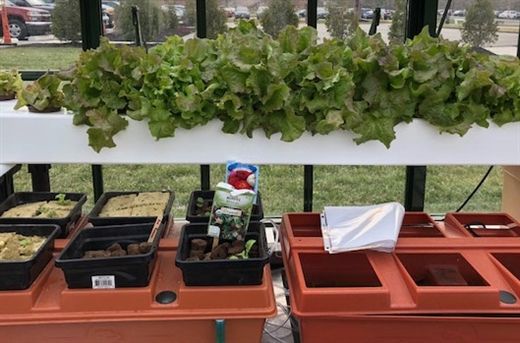

Starting a Garden
Source/Author: SAGE Dining Services
March 26, 2019
Did you know that more than 200 of the school communities SAGE serves have a type of garden — from simple herb boxes to full-fledged farms? Campus gardens provide endless opportunities for learning, and they have a positive impact on the food and vegetable consumption of the students.
Fences are a good way to keep larger pests like rabbits and deer away from your produce.
Spring means it's time to start planting your garden. If you’re eager to start but new to the gardening game, check out these basic tips and helpful hints. You're just a few steps away from enjoying fresh fruits and vegetables grown right at your own home!
Beginning Considerations
Know your limits—consider your local climate, the length of your growing season, and your family’s availability.
Do your research on when you can expect a plant to yield fruit, and how much. You don’t want to be surprised when your tree doesn’t fruit for seven years, or your tomatoes ripen faster than you can use them!
Pitch a comprehensive plan to your spouse and kids. Include anticipated budget, timeline, and labor needs. The scope of your garden will be limited by your family’s willingness to help!
When & How to Plant
Enter your zip code into this online almanac for a personalized calendar of when to plant based on your climate and growing season.
Gather together tools like work gloves, trowels, hoes, shovels, and rakes. Don’t be shy about asking gardening-savvy neighbors or family members if you can borrow their tools (and their expertise)!
Start small, especially if your family and friends aren’t eager to help you weed and harvest.
Space your crops according to the instructions on the seed packets. If they’re too close together, they’ll have to compete for resources, and they may not grow as well.
Stagger your planting of beans, lettuces, and other fast-growing crops. Once you’ve harvested, you can replant the area to keep the harvest going throughout the season.
Where to Plant
Keep your garden as close as possible to the kitchen. That way, it’s easy to maintain, hard to forget about, and convenient to access when you need to snip off some herbs mid-recipe.
Water needs to be readily available, preferably in the form of an outdoor spigot or hose.
Pick a sunny location. Most vegetables need at least six hours of direct sunlight daily, but some can handle more shade—like broccoli, lettuce, spinach, and other greens. More sunlight means more photosynthesis, which in turn means more fruit, bigger fruit, and better taste.
Plant in a relatively stable area that’s not prone to flooding, drought, or heavy winds.
Good soil—sandy, well-drained, and nutrient-rich—is a must. You may want to compost to add nutrients and improve moisture retention. Remember that composting can bring unwanted odors and pests to campus if executed improperly, so be sure to do it right!
If you have hard, rocky, or clay-heavy soil, you may be better off building raised beds and filling them with good soil, or looking into a vertical garden.
What to Plant
Think about what your family likes to eat, as well as what’s difficult to find or expensive to buy.
Most vegetables grow well from seed—lettuce, beans, carrots, beets, chard, spinach, peas, cucumbers, and squash. For slow-growing produce like tomatoes, peppers, eggplant, and melon, you may get a better fruit by buying seedlings and transplanting them later in the season. If you have more space than money, consider starting your own from seed and keeping them inside for a month or two before planting them outside. However, don’t skimp on seed quality! It’s better to pay a few extra cents per packet than to waste your money and time on seeds that don’t germinate.
If you’re new to gardening, start with easy growers like beets, bell peppers, cabbage, carrots, green beans, lettuce, radishes, Swiss chard, tomatoes, and zucchini.
Choose varieties that will mature in your growing season. One easy way to do this is to plant something uniquely regional, like prickly pears, for use in special events. For unfamiliar plants, read the seed packet or ask local gardeners if they’ve ever tried them out.
Finishing Touches
If you’d like, plant marigolds to control garden pests. They can also be eaten in salads or used as garnish where noted in recipes.
Fences are a good way to keep larger pests like rabbits and deer away from your produce.
To reduce the need for weeding, mulch around your plants with newspaper, dried grass clippings, or other forms of natural ground cover.
Maintain your garden by weeding daily, watering and fertilizing as necessary, and harvesting when fruits become ripe. Compost, coffee grounds, eggshells are a natural way to add nutrients to your soil.
Share your garden with friends and family. Shared meals are a great way to brighten their days and fill their bellies!
Tweak from year to year based on your successes and your family’s preferences.
Learn more from SAGE about growing your own produce here.
Tweak from year to year based on your successes and your family’s preferences.
Learn more from SAGE about growing your own produce here.
























